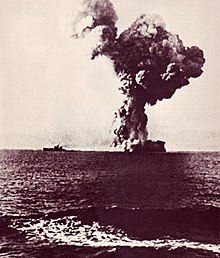|
Italian destroyer Vincenzo Gioberti44°4′0.01″N 9°22′59.99″E / 44.0666694°N 9.3833306°E
Vincenzo Gioberti was one of four Oriani-class destroyers built for the Regia Marina (Royal Italian Navy) in the mid-1930s and early 1940s. Completed in 1937, she served in World War II. She was sunk on 9 August 1943 by the Royal Navy submarine HMS Simoon, and was the last Regia Marina destroyer to be lost in the war against the Allies. Design and descriptionThe Oriani-class destroyers were slightly improved versions of the preceding Maestrale class.[1] They had a length between perpendiculars of 101.6 meters (333 ft 4 in)[2] and an overall length of 106.7 meters (350 ft 1 in). The ships had a beam of 10.15 meters (33 ft 4 in) and a mean draft of 3.15 meters (10 ft 4 in) and 4.3 meters (14 ft 1 in) at deep load.[3] They displaced 1,700–1,750 metric tons (1,670–1,720 long tons) at normal load, and 2,400–2,450 metric tons (2,360–2,410 long tons) at deep load.[4] Their complement during wartime was 206 officers and enlisted men.[2] The Orianis were powered by two Parsons geared steam turbines, each driving one propeller shaft using steam supplied by three Thornycroft boilers.[2] Designed for a maximum output of 48,000 shaft horsepower (36,000 kW) and a speed of 32–33 knots (59–61 km/h; 37–38 mph) in service, the ships reached speeds of 38–39 knots (70–72 km/h; 44–45 mph) during their sea trials while lightly loaded. They carried enough fuel oil to give them a range of 2,600–2,800 nautical miles (4,800–5,200 km; 3,000–3,200 mi) at a speed of 18 knots (33 km/h; 21 mph) and 690 nmi (1,280 km; 790 mi) at a speed of 33 knots (61 km/h; 38 mph).[4] Their main battery consisted of four 50-caliber 120-millimeter (4.7 in) guns in two twin-gun turrets, one each fore and aft of the superstructure.[5] Amidships were a pair of 15-caliber 120-millimeter star shell guns. Anti-aircraft (AA) defense for the Oriani-class ships was provided by four 13.2-millimeter (0.52 in) machine guns. The ships were equipped with six 533-millimeter (21 in) torpedo tubes in two triple mounts amidships. Although they were not provided with a sonar system for anti-submarine work, they were fitted with a pair of depth charge throwers.[4] The ships could carry 56 mines.[5] Fate Vincenzo Gioberti had conducted 216 war patrols, and had travelled some 74,071 nautical miles.[6] On 9 August 1943, Vincenzo Gioberti was with the cruiser Italian cruiser Giuseppe Garibaldi along with several light cruisers and destroyers passing just west of Punta Mesco near the port of La Spezia. The Royal Navy submarine HMS Simoon spotted the Giuseppe Garibaldi and fired three torpedoes at her, but missed and instead two hit Vincenzo Gioberti. The stern magazine detonated and exploded, and the destroyer broke into two pieces. 105 officers and men died, while 171 were rescued. She was the last Regia Marina destroyer to be lost in the war against the Allies.[7] The bow section went on and sank about one mile away from the impact, the wreck of which is located at a depth of about 600 metres.[6] CitationsBibliography
External links
|
||||||||||||||||||||||||||||||||||||||||||||
